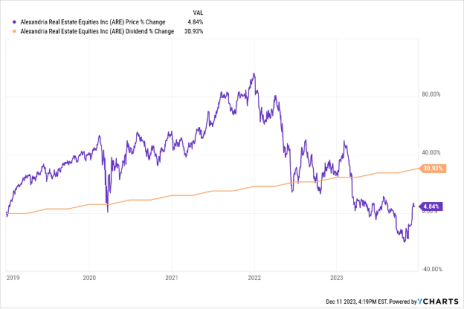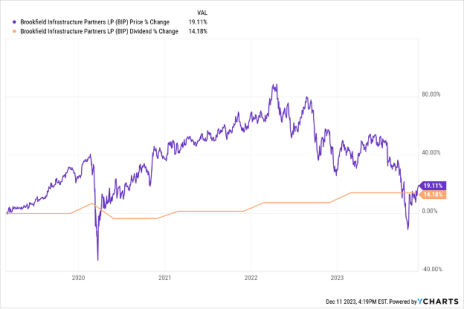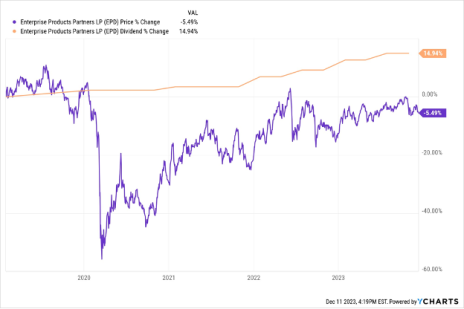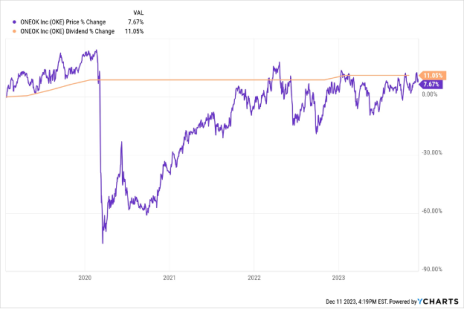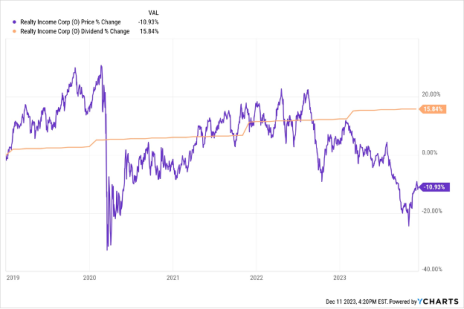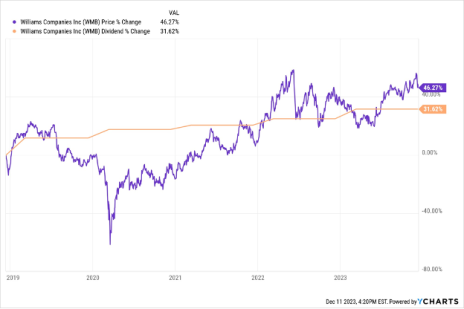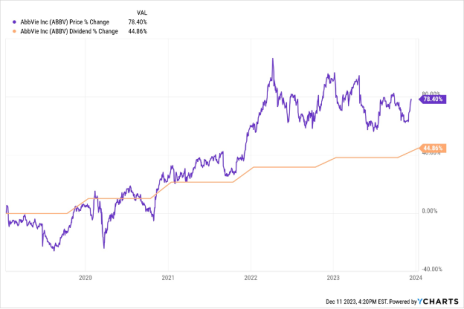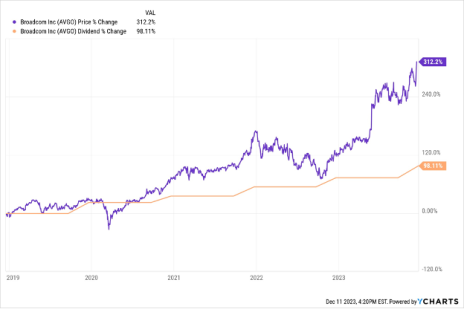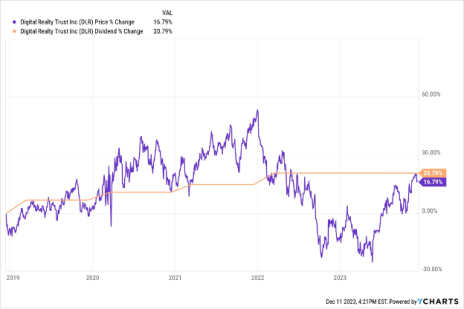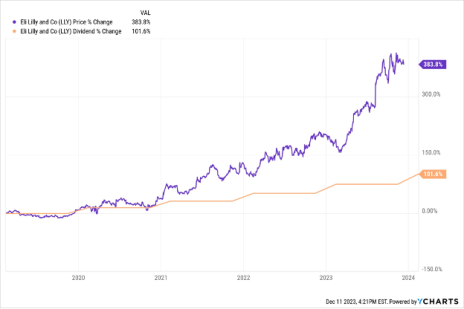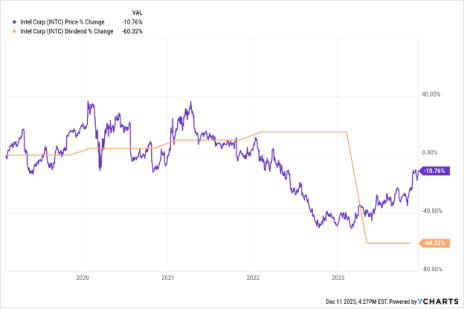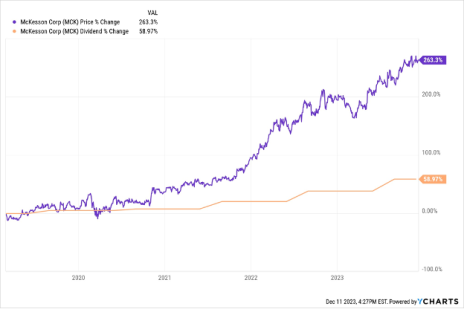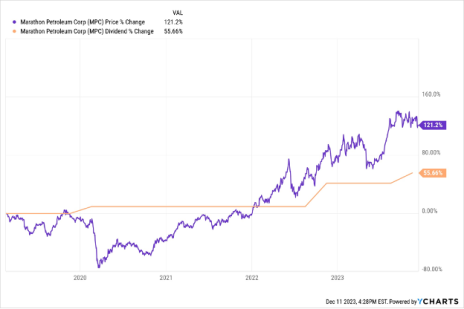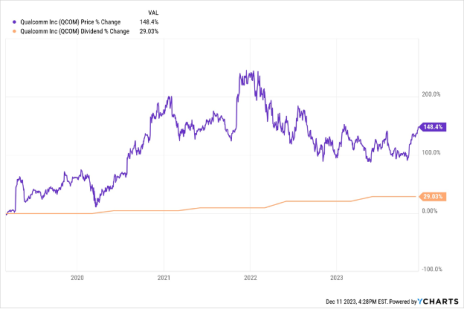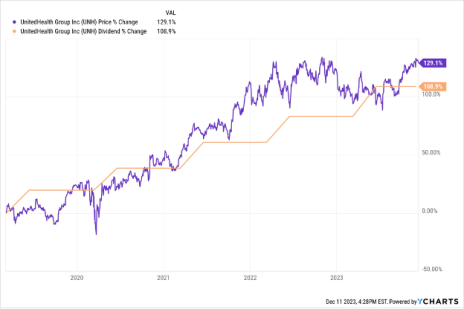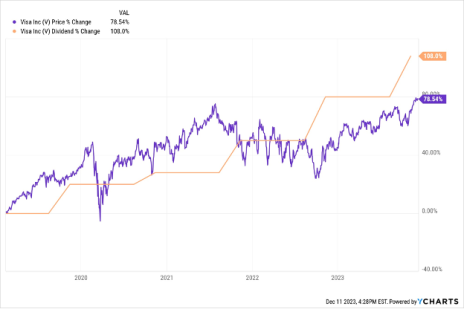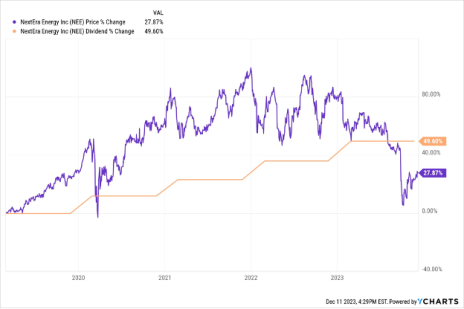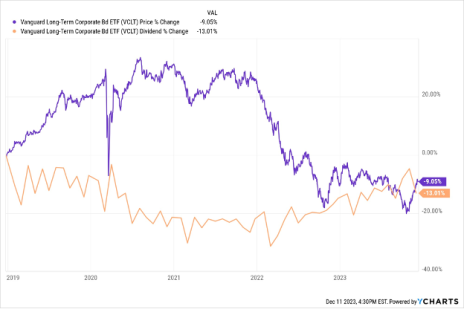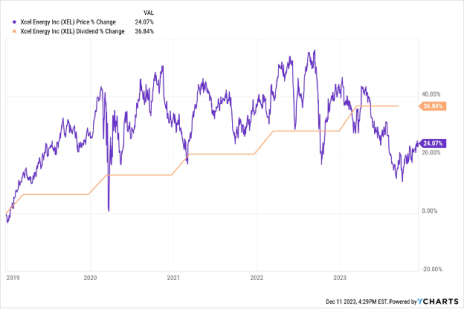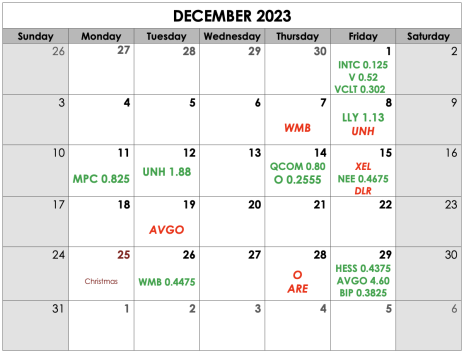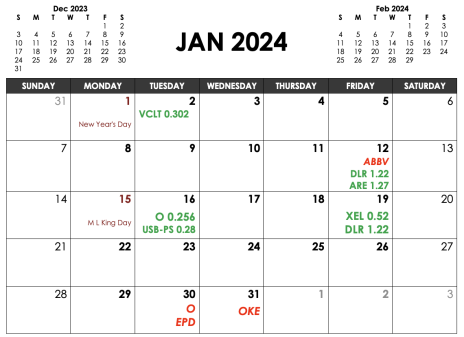Exploit the Interest Rate Peak
The market is changing for the better.
For the last two years, inflation and rising interest rates have plagued the market. Last year was a bear market and this year most stocks have struggled. But it appears that the market’s chief nemesis has been slayed, and many stocks could be poised to rally.
Inflation is under control and interest rates have peaked – at least that’s the current consensus Wall Street opinion. Anything is possible. But the market usually gets it right. The peak interest rate consensus was born at the beginning of November when the Fed indicated it is done hiking the Fed Funds rate and inflation and employment numbers emboldened that likelihood.
The benchmark 10-year Treasury yield touched the psychologically important 5% level at the end of October. But the rate has plunged to 4.2% since. As a result, the S&P 500 reversed a three-month decline and rose 12.4% from the recent low.
We’ll see how this new year unfolds. It’s possible that current expectations are wrong, and inflation reignites, sending interest rates to new highs. The recession that has been avoided so far could develop in 2024. There are still risks out there. But the odds are high that interest rates have peaked. Rising interest rates have killed many stocks for two years. The elimination of that negative force should enable some beaten-down stocks to rise sharply off multi-year lows in the new year.
According to the indexes, a new bull market began many months ago. After a bear market in 2022, the S&P rose more than 20% off the lows in 2023. But the index returns are deceiving. Just seven large-cap tech stocks accounted for almost all the positive returns. As of the middle of November, the “Magnificent Seven” stocks, which account for 29% of the S&P 500, collectively returned an average of 71% for the year while the other 493 stocks on the index mustered only a collective 6% return.
That 6% return is a lame recovery from the carnage of 2022. Many stocks are still in a bear market. In fact, certain interest rate-sensitive stocks recently fell to the lowest level since the trough of the pandemic market more than three years ago, although they have rebounded with interest rates falling recently. Buying stocks in the throes of a bear market has proven to be a winning strategy over time. Buying stocks after they have already started to climb out of the lows has proven to be a winning strategy sooner.
The timing may be perfect for a rare opportunity to generate much higher returns than can normally be expected from stocks of defensive companies. In this issue, I highlight a defensive stock that had been a stellar performer before inflation and rising interest rates took hold. It is priced near the lowest valuations in its history and has recently been generating upward momentum.
What to Do Now
Most analysts are optimistic about stocks for the new year, although about half of economists are calling for a recession. But most see a very mild recession. The major market impediments, inflation and rising rates, are subsiding and reversing. Next year should be positive even with a mild recession.
But anything is possible. There are still risks. Inflation could reignite and rates could move higher again. There could be a recession that turns out worse than expected. Geopolitical things could get ugly and trump everything else for a time. And 2024 is a big election year.
But the risks seem more toward a slowing economy and recession rather than still-rising inflation and interest rates. That sets up well for the beleaguered defensive stocks. At the same time, artificial intelligence (AI) isn’t going anywhere. Companies will continue to spend big on the technology regardless of the economy, the Fed, or who is president.
Looking ahead to 2024, I like the battered defensive stocks. Despite the recent impressive move off the bottom, many are still very cheap, and the major obstacle has been removed. It should also be another good year for technology.
I love all the currently BUY-rated stocks in the portfolio. But you may not be able to purchase all of them. Therefore, I will identify the stocks I would buy at this point in time if I could only buy five of them. They are my current “buy first” stocks.
I would favor the current BUY-rated stocks NextEra Energy (NEE), Xcel Energy (XEL), Brookfield Infrastructure Partners (BIP), and Realty Income (O) because of the reasons mentioned above. The technology stocks look attractive as well. However, Broadcom (AVGO) has had a huge move this year and is above the optimal buy price and Intel (INTC) has also had a big upside move recently.
Qualcomm (QCOM) would be my pick among the three right now because it has lagged the technology sector this year and has just recently started moving. QCOM should have its big surge next year.
Recent Activity
November 22
SOLD Hess Corporation (HES) - $144.40
SOLD Tractor Supply Company (TSCO) - $198.44
December 6
NextEra Energy, Inc. (NEE) - Rating change “HOLD” to “BUY”
December 13
Buy Alexandria Real Estate Equities (ARE)
Current Allocation | |
| Stocks | 52.5% |
| Fixed Income | 19.5% |
| Cash | 28% |
Featured Action: Alexandria Real Estate Equities (ARE)
Alexandria Real Estate Equities (ARE) is a U.S.-based Real Estate Investment Trust (REIT) specializing in office buildings and laboratories leased to tenants primarily engaged in the life science and technology sectors. It has over 800 tenants primarily in locations that are clusters for innovation in greater Boston, the San Francisco Bay area, New York City, San Diego, Seattle, and Washington, D.C.
The state-of-the-art laboratory properties are mostly clustered in urban life science, agricultural technology, and technology campuses in the U.S. Properties are leased to tenants under long-term triple net leases with automatic rent escalations. Triple net leases account for just about all of revenues. Tenants pay everything, including insurance, taxes, utilities, and maintenance. They provide a big advantage by eliminating unexpected and variable expenses and provide a much more predictable revenue stream.
These kinds of properties have high demand that should continue to grow for many years to come. We are in the midst of dual megatrends of a technological revolution and an aging population. Innovation is the key to the future and Alexandria’s properties are among the best. The innovation clusters are also the highest-demand properties by the very best companies and have high barriers to exit.
Alexandria’s tenants are major pharmaceutical, biotech, life science, and technology companies. The biggest tenants include Bristol-Myers Squibb (BMY), Moderna (MRNA), and Eli Lilly (LLY).
For many years, ARE delivered the performance one would expect from a high-quality REIT operating in a growing space. It performed on par with the S&P 500 during a bull market with less volatility and blew away the returns of the REIT index in every measurable period for 10 years. But things turned ugly in the beginning of 2022. Since the start of last year, ARE has crashed 40%.
The fall in price isn’t because of internal or fundamental reasons. Revenues, earnings, and occupancy rates have remained solid. Revenues are up 10.9% in the first nine months of 2023 and earnings have grown in the high single digits. It’s the macro environment that has battered this stock.
REITs have been one of the worst-performing market sectors over the last two years because of rising interest rates. Higher interest rates make alternative income-generating investments in the fixed-income arena more competitive. The higher rates also increase the cost of funding for REITs that need to borrow money to expand because they are required to pay out the bulk of earnings in dividends.
The inflationary and rising interest rates environment caused the Vanguard Real Estate Index Fund (VNQ) to fall 25% over the last two years. But ARE fell a lot more because of another issue. Alexandria is technically classified as an office REIT, and office space is in crisis. After the pandemic, many workers continue to work at home and are not returning to the office. In several major cities, office occupancy rates remain as low as 60%.
The work-from-home trend is expected to continue, and workers are not expected to return to offices at anywhere near pre-pandemic levels. There is currently way more office space available than demand. Investors understand this and are avoiding office REITs like the plague. In an unforgiving market, ARE has been subjected to the double whammy of rising interest rates and the crash of office properties.
But the problem doesn’t apply to Alexandria’s properties. The market has been blind to the distinction and has thrown the baby out with the bathwater. Sure, if all you need is a cubicle and a computer you can work from home. But laboratories can’t be duplicated at home. And the related offices provide a level of innovation and collaboration that requires people to be there. That’s why Alexandria’s properties have a 93.7% occupancy rate that is expected to grow in the quarters ahead.
Alexandria’s properties are mostly immune to the work-from-home trend. Not everybody can work at home. Airline pilots can’t do their job from home. Professional football players can’t play from home. And scientists and technology innovators can’t whip up a state-of-the-art laboratory in their spare bedrooms.
Market overreactions are almost always corrected eventually. As investors warm to REITs again because of peak interest rates, cheap valuations, and high dividends, they are likely to embrace the bargain currently offered with ARE.
ARE currently sells near its lowest-ever valuations. And the yield is high at 4.3%. The dividend is well-supported with a payout ratio at just 55% of adjusted funds from operations (AFFOs), which is low for a REIT. Alexandria also preserves cash for expansions and acquisitions without having to borrow as much money as most competitors. The debt-to-equity ratio is a reasonable one-to-one and the debt has investment-grade ratings with a positive outlook. The REIT also has $5.9 billion available in liquidity which is plenty of dry powder for future growth.
It’s well worth noting that Alexandria has raised the dividend every year for the past 14 years. It takes solid and reliable earnings to do that, which is why stocks of companies that grow their dividend tend to be the best market performers over time.
ARE is a rock-solid REIT with highly reliable state-of-the-art properties that attract the very best innovative life science, biotech, and technology companies. It’s just been through its own horrible bear market because of an unusual macro environment that has likely changed.
Anything is possible regarding the economy and interest rates going forward. But even if the economy turns south next year, this is a very defensive REIT with a price that has already been beaten to a pulp. It is likely to hold its own from here in any type of market.
The current beleaguered state of the stock and low, low price presents a rare opportunity to get a much higher total return than is usually possible from an investment this defensive. ARE currently offers much more upside potential than downside risk.
Alexandria Real Estate Equities, Inc. (ARE)
Security type: Real Estate Investment Trust (REIT)
Sector: Office (Healthcare)
Price: $117
52-week range: $90.73 - $172.65
Yield: 4.3%
Profile: Alexandria is a REIT that owns and leases specialized laboratory and office properties to tenants engaged in life science, biotechnology, agtech, and technology primarily in urban innovation and research clusters.
Positives
- Demand for these specialized properties is growing.
- Tenants are leaders in their industry and sign long-term triple net lease contracts.
- The stock is oversold because of rising interest rates and an unjustified association with the office REIT space.
Risks
- Interest rates are likely to remain higher than in the past and funding costs will be higher.
- Inflation and interest rates may rise and pressure on the REIT sector could continue.
Alexandria Real Estate Equities, Inc. (ARE)
Next ex-div date: December 28, 2023
Portfolio Recap
High Yield Tier | ||||||||||
| Security (Symbol) | Date Added | Price Added | Div Freq. | Indicated Annual Dividend | Yield On Cost | Price on Close 12/11/23 | Total Return | Current Yield | CDI Opinion | Pos. Size |
| Brookfield Infrastructure Ptnrs. (BIP) | 6.38% | 29 | 38% | 5.40% | BUY | |||||
| Enterprise Product Partners (EPD) | 7.14% | 26 | 33% | 7.60% | BUY | |||||
| ONEOK Inc. (OKE) | 7.20% | 67 | 49% | 5.70% | BUY | |||||
| Realty Income (O) | 54 | 2% | 5.65% | BUY | ||||||
| The Williams Companies, Inc. (WMB) | 8/10/22 | 33 | Qtr. | 1.79 | 5.40% | 35 | 15% | 5.13% | BUY | 1 |
| Current High Yield Tier Totals: | 6.20% | 24.80% | 6.00% | |||||||
Dividend Growth Tier | ||||||||||
| AbbVie (ABBV) | 151 | 144% | 4.10% | BUY | ||||||
| Broadcom Inc. (AVGO) | 1029 | 146% | 2.00% | HOLD | ||||||
| Digital Realty Trust, Inc. (DLR) | 135 | 16% | 3.60% | BUY | ||||||
| Eli Lily and Company (LLY) | 584 | 302% | 0.90% | HOLD | ||||||
| Intel Corporation (INTC) | 45 | -1% | 1.10% | BUY | ||||||
| McKesson Corporation (MCK) | 462 | 1% | 0.50% | BUY | ||||||
| Marathon Petroleum Corp. (MPC) | 144 | 1% | 2.30% | BUY | ||||||
| Qualcomm (QCOM) | 136 | 77% | 2.30% | BUY | ||||||
| UnitedHealth Group Inc. (UNH) | 544 | 6% | 1.40% | BUY | ||||||
| Visa Inc. (V) | 12/8/21 | 209 | Qtr. | 1.8 | 0.90% | 257 | 25% | 0.81% | HOLD | 1 |
| Current Dividend Growth Tier Totals: | 2.90% | 64.10% | 1.90% | |||||||
Safe Income Tier | ||||||||||
| 60 | 52% | 3.10% | BUY | |||||||
| U.S. Bancorp Depository Shares (USB-PS) | 10/12/22 | 19 | Qtr. | 1.13 | 6.10% | 19 | 5% | 6.00% | BUY | 1 |
| 77 | 0% | BUY | ||||||||
| Xcel Energy (XEL) | 10/1/14 | 31 | Qtr. | 2.08 | 6.70% | 62 | 166% | 3.40% | BUY | 1 |
| 5.30% | 55.80% | 4.40% | ||||||||
Brookfield Infrastructure Partners (BIP – yield 5.4%) – This infrastructure partnership was moved from the Dividend Growth Tier to the High Yield Tier last week. The 5.4% yield makes it a high-income stock and the rise in yield is prompted by lousy performance. BIP has been bludgeoned over the past two years by rising interest rates. But things are changing. It is likely rates have peaked and interest rate-sensitive stocks have been rallying. BIP has rallied about 36% off the low made at the end of October. With peak interest rates and reliable earnings at a likely premium, BIP could be a star again in 2024. (This security generates a K-1 form at tax time). BUY
Brookfield Infrastructure Partners (BIP)
Next ex-div date: February 28, 2024, est.
Enterprise Product Partners (EPD – yield 7.6%) – This midstream energy partnership has been trending very slowly higher all year. It bounces around in an upward trend. The results haven’t been exciting, but that massive yield is safe, supported by 1.7 times cash flow coverage. In fact, Enterprise just increased its distribution by 5.3% in the last quarter.
The growth in profits and distributions is likely to continue as the partnership is expanding operations in the high-growth Permian basin. EPD, like other midstream energy stocks, tends to get knocked around with oil prices and the energy sector in the near term. But its lack of reliance on commodity prices wins out over time. That’s why EPD has returned 17% YTD while the overall energy sector is down 7%. (This security generates a K-1 form at tax time). BUY
Enterprise Product Partners (EPD)
Next ex-div date: January 30, 2024, est.
ONEOK Inc. (OKE – yield 5.7%) – This midstream energy company had moved near the 52-week high at the beginning of this month. But OKE has pulled back with the rest of the energy sector over the past few weeks. It’s well-supported high dividend and reliable earnings will prevail over time. ONEOK reported solid earnings with adjusted EBITDA growth of 11% over last year’s quarter as natural gas volumes were up 12%. The company also raised the guidance on projected consolidated earnings going forward. I expect more of the same solid performance. BUY
ONEOK Inc. (OKE)
Next ex-div date: January 31, 2024, est.
Realty Income (O – yield 5.6%) – The legendary income stock should be a great buy right now. It’s cheap. O sells more than 30% below the all-time high set before the pandemic. There is upward momentum. It has moved 20% off the bottom set in October. And interest rates have likely peaked, removing the main downside catalyst that has been in place for the past two years. And its retail staple properties and new data center acquisitions should produce reliable revenue in just about any economy. BUY
Realty Income (O)
Next ex-div date: December 31, 2023, est.
The Williams Companies, Inc. (WMB – yield 5.1%) – The natural gas pipeline company reported strong earnings growth and moved to within pennies of the 52-week high. But WMB has pulled back this month along with the rest of the energy sector as oil prices fell below $70 per barrel. But business remains solid and not dependent on commodity prices. It pays a well-supported dividend (with 2.38 times cash flow coverage). Recent acquisitions and expansions ensure more solid growth going forward all the way out to 2028. This should be a solid holding in any environment. BUY
Williams Companies, Inc. (WMB)
Next ex-div date: March 8, 2024, est.
AbbVie (ABBV – yield 4.1%) – The biopharmaceutical company had a nice move higher in the last few week. AbbVie announced it is buying biotech company ImmunoGen (IMGN) for $10.1 billion in cash in a deal slated to close early next year. ImmunoGen is a cancer therapy specialist that fits nicely with AbbVie’s pipeline. Seven days later, AbbVie announced it is also buying Cerevel Therapeutics (CERE) for $8.7 billion.
Both deals should enhance the already strong pipeline longer term. But its current pipeline should lift the stock sooner. Its two new biosimilar drugs, Rinvoq and Skyrizi, grew sales by more than 50% in the last quarter and the company expects these drugs alone to eventually surpass Humira’s peak sales. The stock sells at a low valuation and investors sense that it might turn the Humira corner sooner ahead of a very bright future. BUY
AbbVie Inc. (ABBV)
Next ex-div date: January 12, 2024
Broadcom Inc. (AVGO – yield 2.0%) – It’s another new high! The already strong-performing fabless chip and software company stock rocketed 16% higher over the last week. The reason is because the company reported earnings that impressed the market. Earnings remained solid and Broadcom also cited future earnings gains from its recent VMware acquisition as well as the potential to double AI revenue from $4 billion in 2023 to over $8 billion in 2024. Its chips basically provide the network infrastructure that enables AI systems. The company also received an analyst upgrade with a raised price target. HOLD
Broadcom Inc. (AVGO)
Next ex-div date: December 19, 2023
Digital Realty Trust, Inc. (DLR – yield 3.6%) – This data center REIT has pulled back from the recent new high. Even though REITs have been terrible this year, DLR has now returned about 40% YTD. It looks like REITs have bottomed out and are on their way higher as interest rates have likely peaked. Digital also has the additional catalyst of increasing AI spending and is getting a boost from the AI craze. BUY
Digital Realty Trust, Inc. (DLR)
Next ex-div date: December 14, 2023
Eli Lilly and Company (LLY – yield 0.9%) – This stock is a star with a YTD return of 60% and an average annual return of 55% over the last three years. But LLY has been in a sort of holding pattern for a couple of months. It’s not making new highs but it hasn’t had a pullback of any significance either. It’s hanging tough at the high point of the recent range after a big surge earlier in the year. Weight loss drug Mounjaro was approved by the FDA last month. Some analysts estimate it could potentially be a $20 billion per year drug. That would match the best-selling drug ever. It still has its Alzheimer’s drug up for FDA approval in the months ahead. HOLD
Eli Lilly and Company (LLY)
Next ex-div date: February 15, 2024, est.
Intel Corporation (INTC – yield 1.1%) – INTC is bouncing around after the recent surge. The chip maker recently hit a 17-month high and was up over 27% in a month and about 66% YTD. And the stock is still close to the 52-week high. It’s a good sign that INTC isn’t giving back the recent surge. Earnings indicate that Intel’s turnaround is well on track. It has promising new chips coming out in high-growth areas and its foundry business could be huge. The stock got dirt cheap, and investors are increasingly willing to bet on the company’s future. BUY
Intel Corporation (INTC)
Next ex-div date: February 6, 2024, est.
McKesson Corporation (MCK – yield 0.5%) – This massive pharmaceutical distributor hasn’t done much since it was added to the portfolio in October. Other sectors have taken the spotlight in the market rebound. But MCK has returned more than 23% YTD in a year when most healthcare and other defensive stocks have struggled mightily. It has a business that will continue to thrive even if the economy slows next year. It’s a defensive and growing business and the stock should be a great holding in any environment. BUY
McKesson Corporation (MCK)
Next ex-div date: February 28, 2024, est.
Marathon Petroleum Corporation (MPC – yield 2.3%) – This newly added oil refiner stock has pulled back a little bit with the rest of the energy sector over the past couple of weeks. But it is still hanging tough near the top of the recent range since the end of the summer. MPC has blown away the performance of its peers and the overall market for several years. Even though the energy sector is negative YTD, MPC has managed a better than 26% return. While the environment can vary from quarter to quarter, it should remain an overall profitable environment for refiners over the next several years. BUY
Marathon Petroleum Corporation (MPC)
Next ex-div date: February 15, 2024, est.
Qualcomm Inc. (QCOM – yield 2.3%) – QCOM has severely lagged the overall tech sector this year. But the catch-up may have already begun. It’s up over 30% in the past few months. Qualcomm is introducing new AI chips for PCs and smartphones that could be big sellers next year. Also, strong smartphone sales in China are indicating a bottom. It’s looking like 2024 could be a much better year and QCOM has already started to ascend. BUY
Qualcomm Inc. (QCOM)
Next ex-div date: February 28, 2024, est.
UnitedHealth Group Inc. (UNH – yield 1.4%) – This healthcare insurer has a spectacular long-term track record but has struggled somewhat with just a 3% return this year. Most healthcare stocks have struggled in the 2023 market for a host of reasons. But those reasons are unlikely to persist going forward. UNH has been rejuvenated of late and is on the move. It’s up 15% in the last few months and recently hit a new 52-week high. UNH could continue to move higher and make up for lost time as different stocks come back into favor. BUY
UnitedHealth Group Inc. (UNH)
Next ex-div date: March 1, 2024, est.
Visa Inc. (V – yield 0.8%) – This payment processing company is hitting new all-time highs. It has been one of the very best financial companies to own but was held back by the pandemic and last year’s bear market. But earnings have been stellar. While the weakening consumer is a negative, international business and travel is thriving and more than offsetting the negatives for now. It has a strong business that should remain solid in all but a recessionary environment. HOLD
Visa Inc. (V)
Next ex-div date: February 8, 2024, est.
NextEra Energy (NEE – yield 3.2%) – NEE has been bouncing around. But the stock is still in a strong uptrend that began in early October and it’s up over 20% from the 52-week low. The clean energy utility delivered solid earnings and management reiterated previous growth projections and said the company expects to deliver earnings near the top of the expected range through 2026. This stock is still very oversold, especially considering interest rates have likely peaked. BUY
NextEra Energy Inc. (NEE)
Next ex-div date: February 22, 2024, est.
USB Depository Shares (USB-PS – yield 6.0%) – Recent developments have been great news for this and other fixed rate investments. Interest rates appear to have peaked which means the selling is over in fixed income and prices are likely to rise as rates fall. The price has recovered nicely since the end of October. And USB-PS has now returned over 4% since being added to the portfolio a little over a year ago despite the fact that 2023 has been another terrible year for fixed-rate securities. BUY
U.S. Bancorp Depository Shares (USB-PS)
Next ex-div date: January 15, 2024
Vanguard Long-Term Corp. Bd. Index Fund (VCLT – yield 4.9%) – Peaking interest rates are also a huge positive for VCLT, as evidenced by the recent 15% price surge from the low in October. This long-term bond fund is very sensitive to interest rates. It held up relatively well in the rising rate environment and now it looks like rates are trending lower. BUY
Vanguard Long-Term Corp. Bd. Index Fd. (VCLT)
Next ex-div date: January 2, 2024, est.
Xcel Energy (XEL – yield 3.4%) – This clean energy utility stock has been trending higher since the beginning of last month. The low may be in. XEL had a convincing 13% move off the low. But, like NEE, XEL came under pressure last week as analysts expressed concern about the solar energy business amid the current high interest rates. But this is one of the best utility stocks to own and the recent debauchery may prove to be very temporary. XEL still sells near the lowest levels of the past several years and now has some positive momentum. BUY
Xcel Energy Inc. (XEL)
Next ed-div date: December 15, 2023, est.
Dividend Calendar
Ex-Dividend Dates are in RED and italics. Dividend Payments Dates are in GREEN. Confirmed dates are in bold, all other dates are estimated. See the Guide to Cabot Dividend Investor for an explanation of how dates are estimated.
The next Cabot Dividend Investor issue will be published on January 10, 2024.
